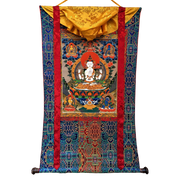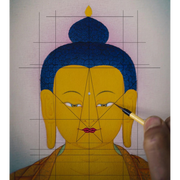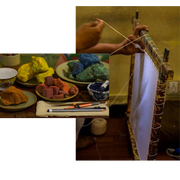Nagarjuna Thangka
BLACK FRIDAY SALE
Get it between - .

Tibetan Thangka painting depicting Basundhara Devi is perfect for various home décor ideas! This 100% hand-drawn Thangka painting made in Kathmandu Valley, Nepal can be decorated as an elegant and eccentric wall hanging in your home or office being a centrepiece of attention. It can also be placed on your family altar for meditation purposes as well as spiritual and emotional healing, attracting benevolent energy of the Tibetan Buddhist art.
- Master Quality Thangka
-
Dimensions: 50 x 38 cm
- Materials: 24 Carat Gold With Tibetan Colors mixed with Hide Glue
- Canvas: Organic Cotton
- Origin: Nepal
- Hand Painted In Nepal
Nagarjuna was an Indian Mahāyāna Buddhist thinker, scholar-saint and philosopher. He is widely considered as one of the most important Buddhist philosophers. Furthermore, according to Jan Westerhoff, he is also "one of the greatest thinkers in the history of Asian philosophy." Nagarjuna is widely considered to be the founder of the madhyamaka school of Buddhist philosophy and a defender of the Mahāyāna movement. His Mulamadhyamakakarika is the most important text on the madhyamaka philosophy of emptiness. The MMK inspired a large number of commentaries in Sanskrit, Chinese, Tibetan, Korean and Japanese and continues to be studied today. Very little is reliably known of the life of Nagarjuna and modern historians do not agree on a specific date or place for him. The earliest surviving accounts were written in Chinese and Tibetan centuries after his death and are mostly hagiographical accounts that are historically unverifiable.
Some scholars such as Joseph Walser argue that Nāgārjuna was an advisor to a king of the Sātavāhana dynasty which ruled the Deccan Plateau in the second century. This is supported by most of the traditional hagiographical sources as well. Archaeological evidence at Amarāvatī indicates that if this is true, the king may have been Yajna Sri Satakarni. On the basis of this association, Nagarjuna is conventionally placed at around 150â250 CE.
A model of the Amaravati Stupa Walser thinks that it is most likely that when Nagarjuna wrote the Ratnavali, he lived in a mixed monastery in which Mahāyānists were the minority. The most likely sectarian affiliation of the monastery according to Walser was Purvasailya, Aparasailya, or Caityaka
He also argues that "it is plausible that he wrote the Ratnavali within a thirty-year period at the end of the second century in the Andhra region around Dhanyakataka (modern-day Amaravati)."
You can find answers to common questions on our FAQ page here.
View all our shop reviews at reviews page here.











